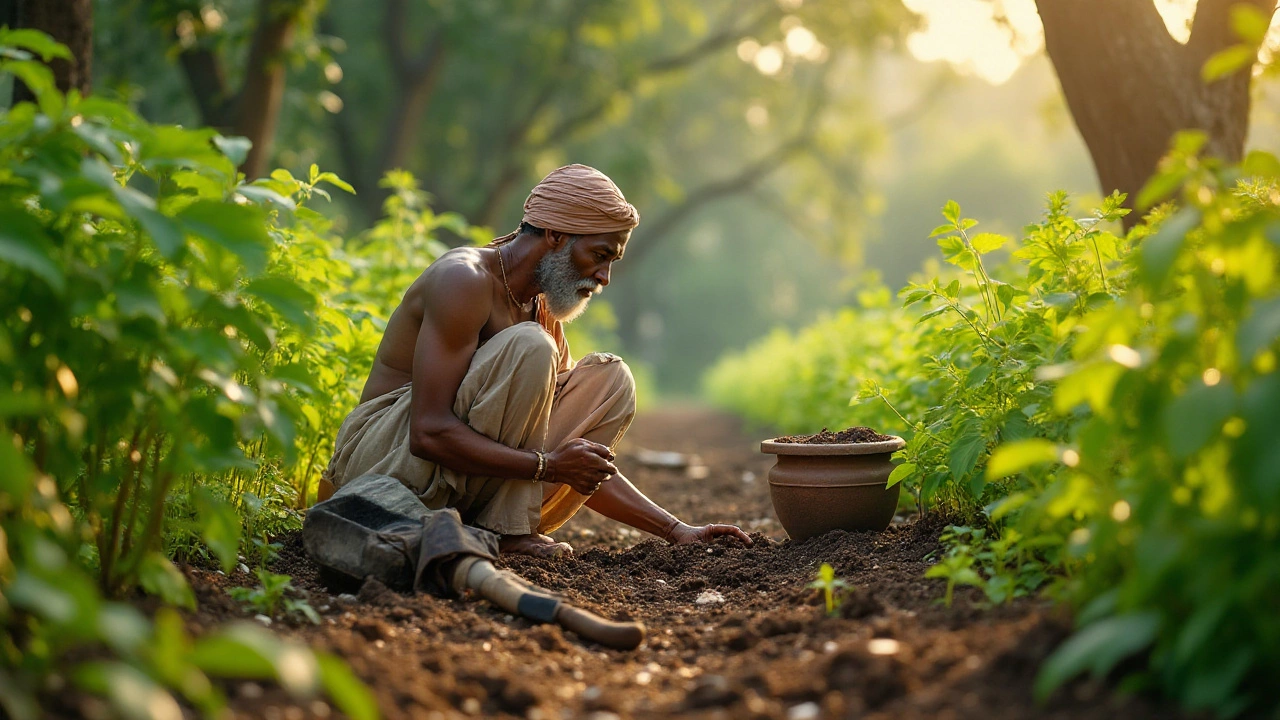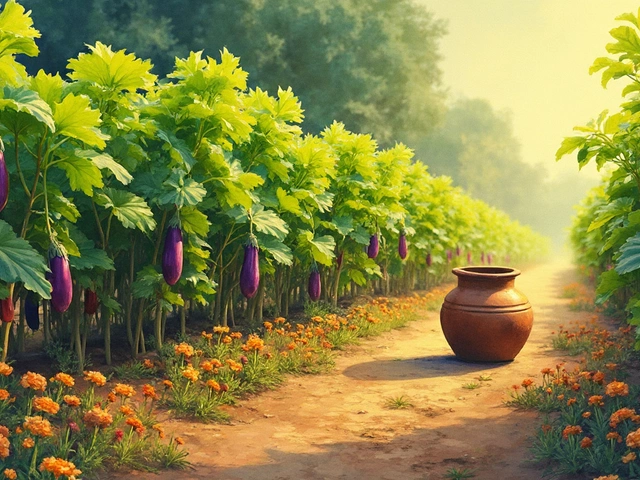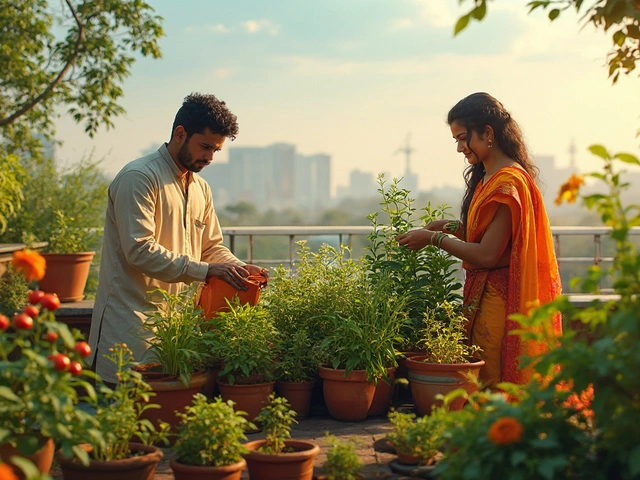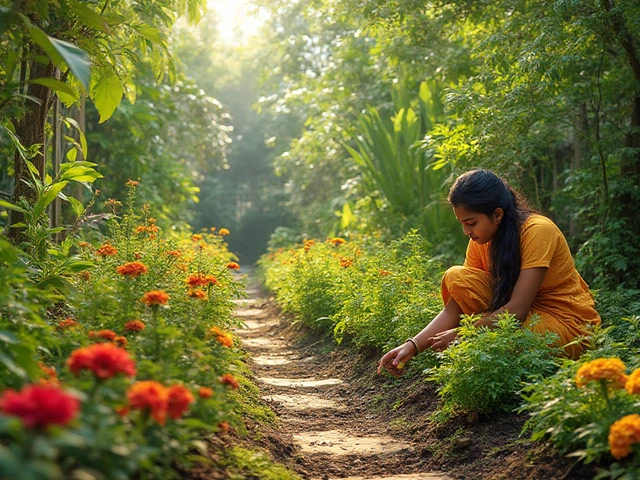Bringing old, tired soil back to life can be a rewarding endeavor, transforming your garden plot into a vibrant, productive space. A well-tended garden begins with understanding the essential building blocks beneath your feet. By embracing a few thoughtful practices, you can turn even the most depleted earth into a haven for plants.
Our journey into soil revitalization begins with a look at its composition and how you can test its quality. Adding organic matter plays a crucial role in improving soil structure and boosting its fertility. Compost is your garden's best friend; learning how to create and incorporate it effectively can make a world of difference.
Moreover, natural additives can help amend your soil. From fish emulsions to crushed eggshells, a little can go a long way. Equally important is the practice of crop rotation, which helps maintain the health of your garden year-round.
Through these insightful tips and practices, you'll be well on your way to breathing new life into your garden soil, ensuring it remains a nourishing foundation for future growth.
- Understanding Soil Composition
- Testing Your Soil
- Importance of Organic Matter
- Composting for Soil Health
- Amending Soil with Natural Additives
- Practices to Maintain Soil Vitality
Understanding Soil Composition
Behind every fertile garden is the secret of soil composition. Essentially, soil is a cocktail of minerals, organic matter, air, and water, each playing a vital role in supporting your plants. The healthy balance of these components decides whether your garden will flourish or struggle. At its core, soil can be divided into three distinct layers: the topsoil, subsoil, and the parent rock. The topsoil is where the magic happens, rich in organic matter and nutrients necessary for plant life. Beneath that, the subsoil contains minerals leached from above, and finally, the parent material forms the deeper, untouched structure beneath.
The Role of Minerals and Organic Matter
Healthy soil is a careful blend of clay, silt, and sand. Clay holds nutrients and retains moisture, while sand provides drainage and allows air to penetrate deeper into the soil. Silt contributes to soil fertility and holds moisture too. But a good soil also needs organic matter. This includes decaying plant and animal material, broken down by microscopic organisms. This organic matter improves soil structure and provides a reservoir for nutrients that feed the plants. It’s crucial to aim for soil that's neither too sticky nor too gritty – and achieving that perfect balance can be a gardener's greatest challenge and triumph."Nature knows best when it comes to nurturing plants. Emulating natural soil processes in your garden could hold the key to your success," suggests renowned soil scientist Dr. Elaine Ingham.
The Importance of Soil pH
Another integral aspect of soil improvement is understanding soil pH. This chemical property signifies the soil’s acidity or alkalinity, measured on a scale from 0 to 14. Most plants prefer a pH between 6.0 and 7.5, where necessary nutrients are optimally available. A soil test can determine where your garden stands in this spectrum, guiding amendments that will help maintain the right conditions. Lime can be used to raise the pH, making the soil more alkaline, while sulfur can lower it, making it more acidic. Mastering the art of modifying soil pH pays off in healthier, more resilient plants.Soil Structure and Aeration
The physical structure of soil, or how well it crumbles, affects aeration and root growth. Compacted soil makes for hard living conditions for plant roots. Ensuring proper air spaces within the soil through organic amendments and regular tilling can promote better root penetration and stronger plant growth. Well-aerated soil also encourages the proliferation of beneficial organisms, which are crucial for breaking down organic matter and recycling nutrients back into a form that plants can absorb.Understanding your soil is like getting to know a new friend – it takes time, but the rewards are endless. Most of all, give your garden the care it craves, and it just might surprise you with the bounty it can produce.
Testing Your Soil
Before embarking on the mission to rejuvenate your garden, it's essential to understand the current state of your soil. This process begins with testing, a crucial step that will shed light on what your soil needs to support healthy plant life. Soil testing might sound daunting, but with the right tools and guidance, it becomes a straightforward and illuminating task. Knowing whether your soil is sandy, clayey, loamy, or compacted guides you in determining the best course of action to improve it for optimal plant growth.
There are several ways to test soil, ranging from simple DIY methods to professional lab testing. A basic soil test kit available at gardening stores can provide immediate feedback on pH levels, which indicates acidity or alkalinity. Most plants thrive in a pH range of 6.0 to 7.5. The soil pH affects nutrient availability, so getting it right is vital to ensure your plants can absorb what they need. Next comes the nutrient analysis, focusing on levels of nitrogen, phosphorus, and potassium—the primary nutrients essential for plant development and growth. These kits offer a great start, but for detailed analysis, sending a soil sample to a lab can offer insights into additional nutrients and potential contaminants.
In some cases, local agricultural extensions or gardening clubs offer soil testing services. Their reports can provide a detailed breakdown of nutrient levels and propose specific amendments. Surprisingly, soil contaminants like heavy metals are sometimes found in urban gardens and should not be overlooked. "Healthy soil is the foundation of a prosperous garden," says Jennifer Smith, director of Gardening New Zealand.
"Understanding what lies beneath your feet allows you to nurture it back to health," she adds, emphasizing the importance of knowledge in soil care.Using this information, you can tailor your soil amendment plan to address deficiencies. One of the simplest and oldest soil tests you can try at home is the ribbon test, which involves rolling a moistened soil sample between your fingers to determine its texture. This can tell if the soil has too much clay, is sandy, or is well-balanced and loamy.
If you’re looking at getting a bit more technical, consider soil moisture and compaction tests. These are often overlooked but can dramatically impact root health. For moisture, take a small handful of soil and squeeze. If it falls apart, it’s too dry; if it stays clumped like a mushy mess, it’s too wet. Ideal soil will hold together in a loose ball. Another approach is the use of a screwdriver or garden fork to check compaction—if these tools don’t easily penetrate the soil, it’s probably compacted and will benefit from aeration. For those who relish precise data, using a penetrometer, a tool that measures soil compaction, can offer numeric results that tell you how easily roots can move through the soil in search of nutrients and water. Carrying out these tests, you gain not only data but a connection with your land, a deeper understanding of what supports or hinders growth beneath the surface.
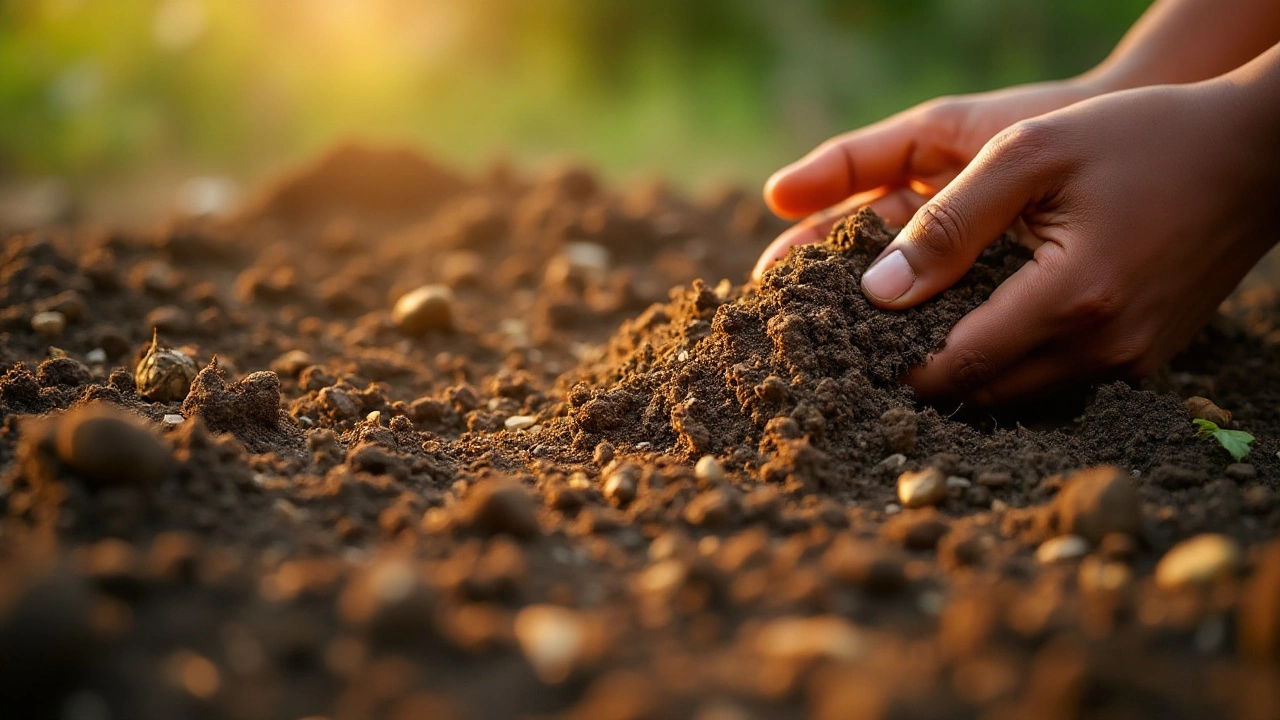
Importance of Organic Matter
In the realm of gardening, organic matter is often regarded as the lifeblood of fertile soil. It's what gives earth its loose, crumbly texture, and teeming microbial life. Imagine your garden as a bustling city, and organic matter is the infrastructure—aiding in aeration, moisture retention, and nutrient supply. When you incorporate organic material, you're essentially laying down the groundwork for a robust ecosystem beneath the soil surface.
Each shovel of decaying leaves, each handful of compost, adds layers of complexity and richness to your garden's soil. Without these enhancements, soil might turn compacted, losing its ability to support plant life effectively. The magic comes from the symphony of decomposition, where microbes break down dead plant material, turning complex organic compounds into simpler forms that are accessible to plants. The release of nutrients such as nitrogen, phosphorus, and potassium is critical. The beauty of organic matter also lies in its ability to improve soil's water retention, reducing the need for excessive watering, which is particularly valuable during dry spells or in arid climates.
The interaction between microbes and organic residues not only replenishes nutrients but also improves plant resilience. Plants growing in soil rich with organic content often show greater resistance to diseases and pests. This could be attributed to the improved root environment—roots find it easier to spread and anchor themselves, tapping into the vital resources they need. As you venture into the gardening world, realize that nurturing your soil by supplementing it with organic matter is more akin to an investment. It's not just about immediate results; it's laying down a foundation for long-term fertility and sustainability.
Soil rejuvenation becomes increasingly important as we face challenges like climate change and soil degradation. The importance of maintaining soil health can't be stressed enough. According to a study conducted by the Food and Agriculture Organization, around one-third of the world’s soil is moderately to highly degraded due to various factors including erosion, nutrient depletion, and organic matter loss. That's a staggering fact to consider when you understand how pivotal healthy soil is in ensuring food security and ecological balance.
"The nation that destroys its soil destroys itself." – Franklin D. Roosevelt
Moreover, incorporating organic matter isn't a complex task. Start off by nurturing a compost pile with garden clippings, household scraps, and fallen leaves. The richer the variety of organic inputs, the more diverse the microbial community will be. A diverse microbial flora is more apt at creating a balanced ecosystem, bolstering nutrient cycling. Consider green manures or cover crops which are grown primarily for their organic material. These plants are tilled into the soil, providing substantial amounts of raw organic material ready for decomposition.
To further understand and implement organic matter effectively, here’s a brief list of steps: First, assess your soil's current organic content using a simple test or analysis. Once you have an understanding, strive to increase it by adding compost, mulches, or well-rotted manure. Remember to rotate your crops, thereby maintaining soil structure and avoiding the depletion of specific nutrients. An added step is to use earthworms in your soil, as their tunneling helps aerate and enhance the overall structure. It's these small but vital changes that could make even the most exhausted plots teem with life once more.
Composting for Soil Health
Composting is a natural way to enhance the fertility and structure of your garden soil. By returning organic matter back to the earth, you mirror the processes that occur in nature. This not only enriches your soil with necessary nutrients but also improves its ability to retain moisture, which is crucial in maintaining a lush garden. Composting involves gathering green materials rich in nitrogen, such as grass clippings or fruit scraps, and mixing them with brown materials rich in carbon, like dried leaves or paper. The balance of these elements is key to achieving robust compost. The decomposition process generates heat, aiding in the rapid breakdown of materials and killing off weeds and pathogens in the process.
A common beginner's mistake is forgetting to turn the compost pile regularly. Turning it ensures that all areas of the pile are exposed to oxygen, an essential element for decomposition. No less important is ensuring your compost is not too wet or too dry. You want it to resemble a damp sponge, moist to the touch but not soggy. Excessive water can lead to an anaerobic environment, causing your compost to rot and smell unpleasant. Conversely, a too-dry compost pile will cease decomposition. Observing these simple tips can help maintain the right conditions for the army of hardworking microorganisms that convert waste into rich, earthy compost.
“We can imagine a future where we no longer throw away our organic waste, but see it instead as a resource vital to our soil’s health,” said Albert Bates, author and ecological advocate.
It's worth mentioning that not everything belongs in the compost. Pet waste, meat scraps, and treated wood materials can introduce harmful elements that you want to avoid. Particularly in urban environments, securing your compost bin is necessary to deter foraging animals. Interestingly, studies have demonstrated that composting can reduce household waste by up to 30%, significantly lowering landfill contributions. This practice not only benefits your garden soil but also the environment at large, underscoring the vital role of soil rejuvenation in sustainability. The humble compost heap is much more than a pile of rotting scraps; it's a powerful tool for positive environmental impact and green living.
Clarity in understanding how composting works can be complemented with easy application methods. Whether you choose to use a compost bin or a pile on your garden floor, ensure that it's located in a sunny spot. This warms the material and accelerates decomposition. Remember to cover new kitchen scraps with brown material to reduce the chances of attracting flies. You can speed up the composting process by adding earthworms, which are natural aerators, improving texture as they break through material layers. Within months of diligent care, you'll have nutrient-rich compost, ready to be mixed into your garden, providing your plants with the nourishing boosts they crave.
To encapsulate the profound impact of composting on garden soil, let's examine a simple nutrient table demonstrating improvement:
| Nutrient | Before Composting | After Composting |
|---|---|---|
| Nitrogen | 1% | 4% |
| Phosphorus | 0.5% | 2% |
| Potassium | 0.4% | 1.5% |
This transformation illustrates just a fraction of composting’s potential benefits, indicating both improvement in nutrient content and the soil’s capacity to support lush greenery. Through dedicated composting efforts, you can contribute to revitalizing old soil, prepping your garden for a bountiful season.
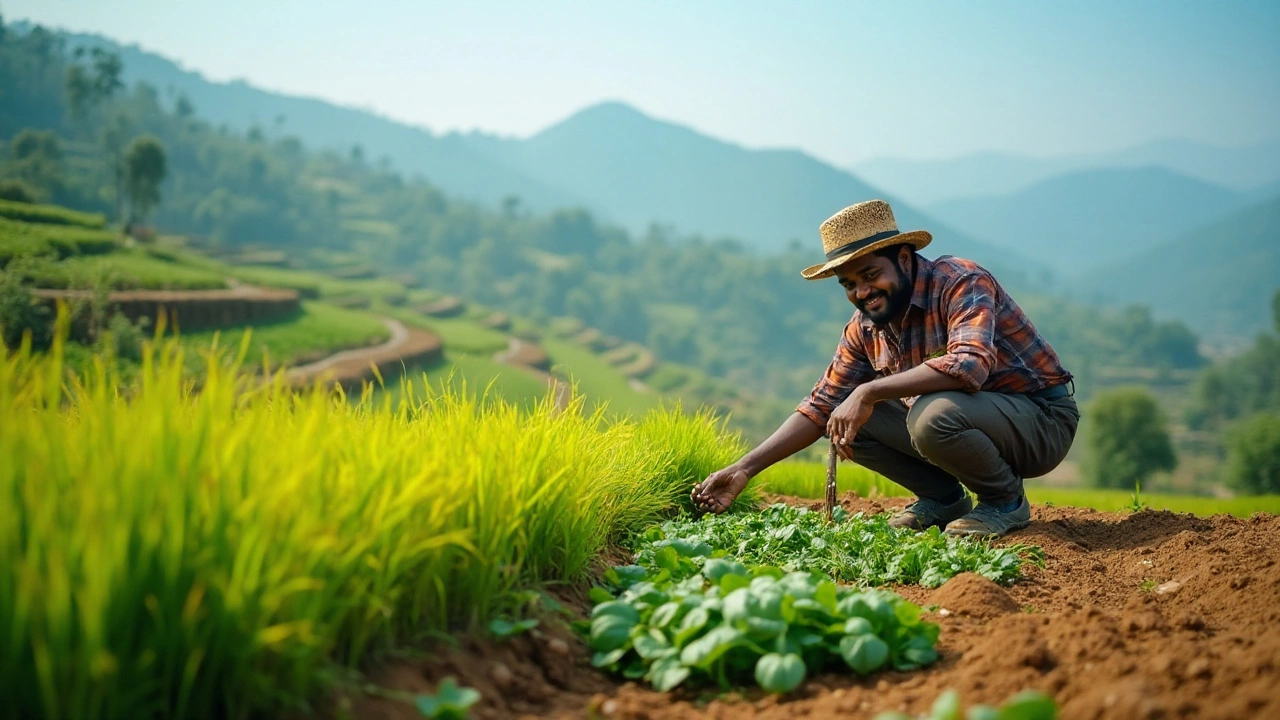
Amending Soil with Natural Additives
Reviving your garden soil often means looking beyond traditional chemical fertilizers and embracing natural additives. These not only enrich the soil but they also enhance its structure and biological activity. It's a method that benefits both plants and the environment, creating a sustainable cycle of nourishment. One of the primary advantages of using natural additives is that they contribute to the nutrient content over a long period, unlike synthetic options that may provide a quick fix but wear off quickly.
Composting is a well-known and effective way to add rich organic matter back into the soil. It involves converting kitchen scraps, garden clippings, and other organic waste into a powerful fertilizer. Not only does compost release nutrients slowly, but it also improves soil aeration and water retention. Another wonderful option is worm castings, commonly known as vermicompost, which is teeming with beneficial microbes that promote healthy plant growth.
"To forget how to dig the earth and to tend the soil is to forget ourselves." – Mahatma Gandhi
Natural mineral additives can also be incredibly beneficial. For example, adding crushed eggshells will introduce calcium carbonate into the soil, which can support plant growth by strengthening root systems. For gardeners in need of enriching soil with essential nitrogen, things like alfalfa meal or fish emulsion can be fantastic. Such choices are typically high in nitrogen, which is a necessary nutrient in fostering the growth of lush, green foliage.
Natural Soil Amendments
But how do you choose the right additive for your soil? Start by assessing what your soil is lacking. Conducting a soil test will reveal which nutrients need to be bolstered. Once you have this information, you can tailor your amendments. If your soil is deficient in potassium, for instance, incorporating a layer of wood ash or banana peels can restore balance. Here’s how some of the natural amendments stack up:
| Organic Additive | Primary Nutrient |
|---|---|
| Compost | Varies (balanced nutrients) |
| Worm Castings | Nitrogen |
| Wood Ash | Potassium |
| Crushed Eggshells | Calcium |
Bear in mind, natural additives do more than just supplement nutrients. They foster an ecosystem teeming with beneficial bacteria and fungi. This results in soil that's not only richer but teeming with life. By encouraging this diversity, you'll create soil that effortlessly supports plant life year after year, making it a sustainable choice for both your garden and the environment.
Practices to Maintain Soil Vitality
Keeping soil vibrant and full of life is a continuous process that involves several mindful practices which enrich and nourish your garden plot. One of the most crucial steps is crop rotation, an age-old agricultural technique that helps prevent pests and diseases from gaining a foothold in your garden. By rotating your crops each season, you make it harder for soil-borne pathogens to thrive, thereby maintaining your garden's health. This practice also helps balance the soil's nutrient levels, as different plants have varying nutrient needs. For instance, leafy greens may deplete nitrogen more than root vegetables, so swapping them around can help keep your soil's nutrient profile balanced.
Another vital practice is the regular addition of organic matter, such as compost or aged manure. Organic matter acts like a sponge, enhancing the soil's structure and water retention capabilities. It also provides a slow-release fertilizer effect, offering a steady supply of nutrients to your plants over time. A garden rich in organic matter is less likely to suffer from compacted soil, which can hinder root growth and make it difficult for water and nutrients to penetrate deeper layers. According to gardening expert James Wong, "A healthy soil is akin to a well-composed symphony; each element must play its part harmoniously to create the lush crescendos in your garden."
Avoiding soil compaction is essential not just for roots to grow but to allow air and water to circulate freely. Stepping stones or paths can help by reducing direct foot traffic on planting areas, thus protecting soil structure. Additionally, mulching can be a game-changer; it reduces soil erosion, maintains moisture, and regulates temperature extremes. Mulches, whether organic or inorganic, create a protective barrier that prevents crusting of the soil surface. Organic mulches, like straw or wood chips, slowly decompose, enriching the soil and supporting organisms that are beneficial to plant growth.
Irrigation is another key player in sustaining soil and overall plant health. Implementing a drip or soaker hose system not only conserves water but also ensures that moisture reaches the plants directly at the root zone. This targeted watering approach minimizes evaporation and runoff, fostering healthier plant growth. An effectively irrigated garden is less stressed, leading to increased resistance to pests and diseases. Consider investing in a moisture meter to guide your watering schedule; it can be a handy tool in understanding when and how much to water.
Furthermore, fostering biodiversity within your garden is a proactive way to maintain soil vitality. Encourage various plants and companion planting, which can naturally deter pests and improve pollination. Native flowers and shrubs also attract beneficial insects, like pollinators and predators of garden pests, creating a balanced ecosystem. Lastly, as much as the soil loves to keep on giving, giving it a rest occasionally is vital. Allow certain areas to go fallow, sans planting, to recover and replenish. This approach, combined with diverse planting methods, will help sustain the land for future gardening seasons.
